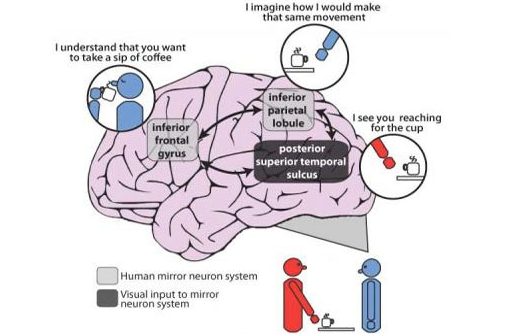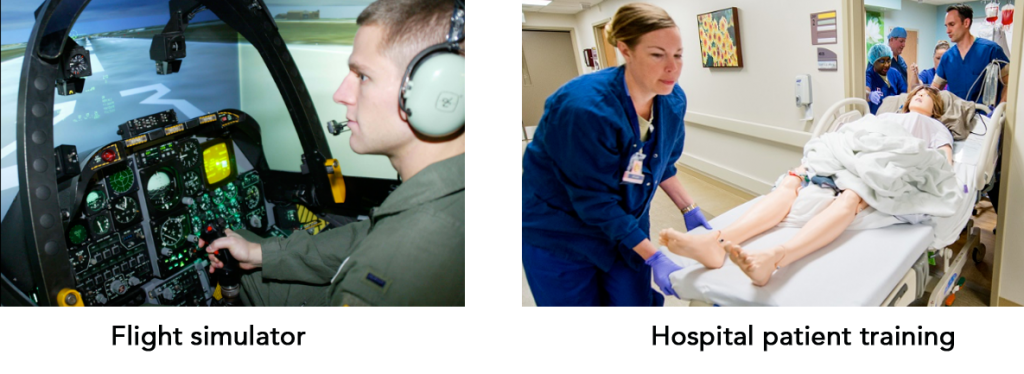
What is a simulation?
Let’s start with a bit of theory: what is a simulation? In a few words, “A simulation is an imitation of a system involving the construction of an artificial history, with the real system features”, according to the 2010 study Simulation – Concepts and Applications.
That means that simulation is a problem-solving tool that helps find the solution to real-world problems as it helps understand the world/system better.
Simulations are used in almost any area nowadays: science, manufacturing, military, transportation, construction, computer, leisure, etc.
They are now part of our everyday life and have various applications: weather forecasts, science tests, test buildings, military training, flight simulations, traffic regulation, video games, etc.
They are used quite often in training now, whether it is hard skills (specific, quantifiable skills that can be defined and measured, such as writing, mathematics, operating a machine, etc.) or soft skills (personality oriented interpersonal skills such as team work, time management, communication, negotiation, etc.).
Simulations are used in almost any area nowadays: science, manufacturing, military, transportation, construction, computer, leisure, etc. They are now part of our everyday life and have various applications.
How do our brains learn?
In order to understand how simulations can accelerate learning, let’s just go a bit deeper into theory before entering fully in the simulation subject and let’s see how the brain actually learns.
The University of California Irvine’s Center for the Neurobiology of Learning and Memory proved during their experiments that, in the brain, neurons bond in order to transmit data more easily and accurately.
These bonds strengthen as they are frequently used, which means that the more they are used, the quicker the information goes and the quicker the task is done. On the contrary, when two neurons rarely interacted, the transmission of information weakens, and the information takes more time to be transmitted.
When the brain learns something new, the neurons have to create new connections, which implies that the person needs greater effort and attention to learn and do this new task.
It’s a bit like driving: if you already know the road, you will drive to the destination without even thinking about it (like going to the office in the morning, going back home after work, etc.).
But when you’re going to a new place, you are more cautious about what’s around you: You study the itinerary, you look at the road signs, etc. And in the end, it will take more time than a route you know perfectly well!
Simulations work the same way!
They are known to help speed up cognitive processes, which are the mental processes that enable people to stock and use information and knowledge; but they also speed up the practical learning of skills and behaviors. To back up this idea, let’s refer to the mirror neurons study.
The mirror neurons were discovered in 1992 by neurophysiologists Giacomo Rizzolatti, Luciano Fadiga, Leonardo Fogassi, Giuseppe Di Pellegrino, and Vittorio Gallese from the University of Parma. They found out that these cells activate when you do some actions, but also when you see them, in order to remember and replicate them.
This is why you yawn when you see someone yawning, for example. What works for basic actions such as smiling and crying also works for athletic performance and complex learning.

In other words, mirror neurons are responsible for the “learning by watching and doing” effect. It also means that you can learn how to change your behaviors by watching and practicing.
Mirror neurons are responsible for the “learning by watching and doing” effect. It means that you can learn how to change your behaviors by watching and practicing.
There is a lot to learn by watching and doing. You can watch and learn to recognize body language and emotional reactions to what you say and do in order to be able to interact better with others.
To know more about the triggers that can help users learn by practice, do not hesitate to read our article (“8 Ways Your Skills Will Improve by Practicing on Digital Role Plays”).
Training in simulations
There are different types of training simulators according to what you want to train in.
You can use, for example, hardware simulators: it can be a training cockpit to train pilots or a plastic dummy to train medical students.

But you can also use software. Training on software is now developing in many organizations. It can be 3D simulators. These simulators can use characters, whether they are real persons or puppets and avatars to interact with the users.
Benefits of training on a simulator
Training in simulations brings some big benefits to the trainees:
• First of all, it increases the user’s involvement. As we saw in one of our previous articles, adult learners don’t like theory and need task-oriented learning. So, in, order to engage trainees in learning sessions, you have to find an interactive and immersive way to involve them and make them practice by themselves.
• Unlike training in a classroom, you can train repeatedly. Simulations can be made as many times as necessary in order to perfectly learn a skill, a behavior, etc. The user can try, and fail, different times in order to learn from his mistakes and find the right approach, and this doesn’t affect other people around him. It is a safe environment.
For example, a pilot can learn safely how to fly and crash a thousand times during simulations, without harming a passenger!
• The “game aspect” of a simulation engages the users much more. As in all games, users want to win. And a training simulator involves you much more in the learning process as you always want to perform better and ‘win.’ As we know, adults learn better by practice, and simulators motivate them practice more as they want to “do better than last time”.
• By training using a simulation software, you can practice anytime, anywhere. Unlike classrooms that you have to physically attend at a definite hour and during a precise amount of time (with all the inconveniences in organization and preparation that it necessities), simulation by software can be completed anywhere and at any time.
This flexibility allows the user to choose the best moment for him to train, when he is more available (both in time and in mind), which makes him more involved in the training, improving its efficiency. For example, a surgeon, with a very busy timetable, can use a slot between two surgeries to train on new techniques on a simulator and master his techniques.
• Training on a simulator, even on a software, makes the training more realistic. The simulation recreates a situation that the user faces in real life every day. Whether it is a flight simulation, a virtual patient or a sales conversation, the user faces a familiar situation. By doing so, he trains his skills and applies them in real life without even noticing.
This is where the mirror neurons come into play. If the simulation is realistic enough, the brain doesn’t differentiate, thus learning as if it was the reality.
Let’s use the example of the flight simulator: by practicing on his simulation for hundreds of hours, the pilot-to-be gains in reflexes and automatisms.
He will perform the maneuvers to take off and land without even noticing (remember the example about driving that we talked about previously!) and gain reflexes on how to react in stressful situations that occurred during the simulation (emergency landing, mechanical problems, bad weather, etc.).
Whether it is a flight simulation, a virtual patient or a sales conversation, the user faces a familiar situation. By doing so, he trains his skills and applies them in real life without even noticing.
Why use a simulation to train leadership
Leadership is essential to better address some critical conversations; you need some key skills and practice to apply them in your day-to-day job. And that’s where simulation can help.
By training on conversations using leadership skills on a Digital Role Play, you can practice and try different approaches and management styles without hurting the feelings of the person in front of you.
Moreover, by using Digital Role Plays, you can learn to recognize the non-verbal language of the person in front of you and understand how to interact accordingly: reassuring him when you see that he is stressed or in doubt, encourage him when he has lost his motivation, inspire your team to face new challenges to come when you feel they are reluctant…everything that can make you a great Leader in your team’s eyes.
To read more about the conversational leadership and the Digital Role Plays to improve it, check out our articles here.
By using Digital Role Plays, you can learn to recognize the non-verbal language of the person in front of you and understand how to interact accordingly: reassuring him when you that see he is stressed or in doubt, encourage him when he has lost his motivation, inspire your team to face new challenges to come when you feel they are reluctant…everything that can make you a great Leader in your team’s eyes.
The typical steps of a conversational simulation
The first step of a typical simulation to train conversational leadership is the preparation to the meeting. The user is given elements to better manage the situation he is about to face.
He can, for example, learn more about the context, the profile of the person he is about to meet, the objectives of the meeting, etc. Once he has learned as much as he can about the situation, he can meet the character.
The simulation starts with a short prologue, then the meeting will take place. The user will talk to the character choosing his words from the set of suggested choices, and the character will answer accordingly. This sequence will be repeated for all the conversation until the end of the meeting.
Once the meeting is over, the user will be asked to assess his performance based on various criteria (skills, steps of the meeting) and then the character will give his subjective feedback on the meeting.
In the end, the user will receive objective metrics on his performance on how to improve his approach for the future conversations, and eventually review the results with his coach to get hints on what to work on.
More details on how a conversational simulation works can be find in this article (“Digital Role Play Stripped Bare”).
Introducing AI into conversational simulations
One of the great innovations of the most advanced simulations dedicated to conversational leadership, also known as digital role plays, is the use of Artificial intelligence instead of the classical branching techniques.
With branching techniques, every choice is predetermined, and the user quickly understands what he has to click on to perform. By doing so, the benefits of this kind of training are totally lost.
On the other hand, with artificial intelligence, the use of different algorithms makes the character’s reactions and behaviors unpredictable, so the user really has to focus on the character’s body language to understand if his approach is the right one or not.
Not only does it make the simulation more realistic (who knows how a real person will react if you push the wrong button), it also makes it more efficient and interesting for the user.
To know more about how AI helps deliver a better training experience, I strongly recommend you read our article (“How AI Helps Delivering a Better SkillGym Training Experience”), regarding how SkillGym leverages AI to deliver a much more authentic and immersive learning experience.
AI becomes even more powerful when combined with interactive video. Why use interactive video and not a puppet as a character? Simply because it makes the role play more immersive and realistic.
- By facing a real person, you are able to see his body language, hear his tone of voice and so on. These elements help you understand if you are managing the conversation in a good way of not and add great value to the role play.
Even if technology has made progress in the design of avatars, nothing can replace a human face for facial expressions or human body language.
- Meeting a real character makes the simulation more immersive and much more realistic. As we saw earlier, realism is the key to activate mirror neurons and learn by doing.
Your brain will never take a puppet for a real person, so you won’t learn by doing as you will by facing a real character, embodied by an actor, with his own personality, triggers, way of talking, etc.
Conclusion
Studies showed that our brain doesn’t differentiate between reality and simulation, which is why simulations are extensively used nowadays in training.
Here at SkillGym, we push reality to the max by combining the use of artificial intelligence and interactive cinema in our Digital Role Plays in order to make the user learn without even noticing and improve his performance in conversational leadership.
If you want to read more about our role plays, please explore the subject in more depth with our articles Digital Role Play Stripped Bare and 8 Ways Your Skills Will Improve by Practicing on Digital Role Plays.
Interested in our approach in building leadership conversation? You may find this article on the curriculum for conversational leadership enlightening.
If you are interested in knowing more about SkillGym and its Digital Role Plays, click here to book a 1-hour discovery call.


